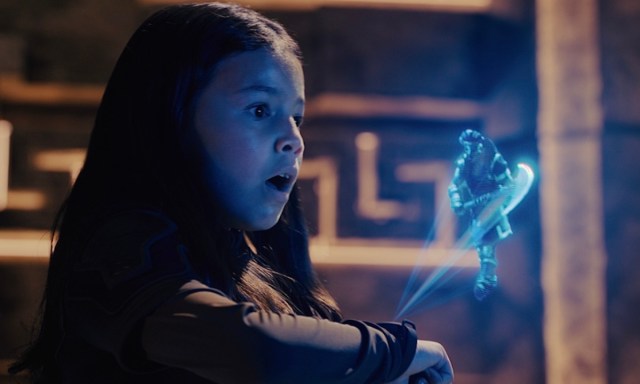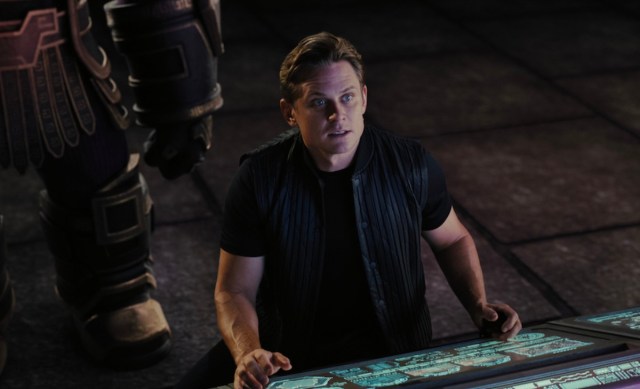In the early 2000s, Robert Rodriguez penned and directed the original Spy Kids franchise. Alexa Vega and Daryl Sabara starred as two children whose lives change overnight when they discover that their parents are actually secret agents working for the OSS — the Organization of Super Spies. (Such non-discrete nomenclature for a top-secret enterprise really helped the franchise dig its feet into the young target demographic.) As for their parents, they were gloriously portrayed by Antonio Banderas and Carla Gugino, who brought heightened passion and playfulness to the combat-ready yet often incautious agents.
The 2023 reboot revisits the original franchise’s premise, replicating its predecessor’s formula in creating a high-stakes mission for the brave-hearted rugrats, Tony (Connor Esterson) and Patty (Everly Carganilla). They must step in when their parents are captured to prevent the cartoon-like villain, The King (Billy Magnussen,) from gameifying the world via a far-reaching virus that gives him control over all technology. How will the baddie accomplish this: via the Armageddon code, which belongs to, you guessed it, our spy kids’ mom and pops (Zachary Levi and Gina Rodriguez).
Fans of the original franchise will appreciate the wacky weaponry and goofy gadgetry that defy all scientific capabilities but lend way to an adventurous high-stakes mission that never feels all-too-threatening. Instead of guns and bombs, we’ve got ultra-sticky goop with indestructible adhesive (once activated) and explosives that, when detonated, can make your opponent super hungry, cute, or giggly. Remember: this is, first and foremost, a children’s movie. Thus, ensuring that the children always feel virtually unassailable, even in the presence of danger, is a must.
It’s clear that Rodriguez is back at the helm, for the film retains the original’s use of adults as extraneous participants who, despite years of training and advanced IQs, cannot seem to concoct a better plan than a single-digit preadolescent. It’s a matter of suspending disbelief and enjoying the ride — a ride that has kids teaching adults lessons about morality and righteousness.
The film, though aimed at children, does tackle super relevant themes — including the threat technology presents to young minds. And, Rodriguez exploits this very relevant subtext to create a threat that children are best equipped to confront — a video game mastermind. Is the game the problem, or the creator?

As for the game’s creator, in walks Billy Magnussen’s “The King,” who boasts that tried-and-true villainous smirk and cringey baddie dialogue reminiscent of the villains in the original franchise. Yet, he’s a bit less animated and lacks the visual absurdity akin to Alexander Minion, who boasted three clay-like faces extending from his primary head. The King is more a CGI-age villain, whose castle responds to his whims and demands. He can create chairs from cement blocks in the walls and stairs miraculously appear when he needs to descend from a threatening height.
This shift, though understandable in the age of CGI, strips away some of the magic inherent to the original franchise. Back then, the villains were built from the ground up via ingenious costume designers and make-up artists. Who could forget the Thumb-Thumbs — whose bodies were comprised entirely of thumbs — or the Timekeeper — who had an antique mini Grandfather clock where a head should be? The practical effects augmented the franchise’s playful atmosphere — each installment seemingly one-upping the last in the ridiculous imagery department.

In Spy Kids: Armageddon, the villains are appropriately video-game-esque (as that is their origin), but it’s abundantly clear that they are entirely computer-generated. We get walking skeletons and highly-armed mega guards who are nowhere near as inventive as the Spy Kids villain of yesteryear. Some of the villains are dressed-up actors, but even they just resemble basic warriors.
While the child-aimed weaponry and gadgetry help compensate for this, we still miss the likes of Alan Cumming’s exuberant Fegan Floop, whose name alone is more buoyant than the “King” and his computerized henchman — let alone his captivating, musically-inclined performance that Magnussen cannot compete with.
While our villainous threats leave much to be desired in the visual originality department, they are just as redeemable as their now decades-old foes. In Spy Kids fashion, the kids teach the old folks a lesson in second chances and leading with compassion.
Spoiler Warning (but you’ll definitely see this coming…)
The villains learn to be better, as do the parents. The simplicity of the child mind — innocence, trust, and wonder — and the unjaded belief that people can change is at the heart of this film. The movie is not about leaving the bad guy behind in a fiery explosion or locking him away for all eternity. It’s about him growing and learning that society is redeemable without force — if you are patient and understanding. And, the parents learn a little something about putting away the fisticuffs and loading their arsenals with hugs and words of encouragement.
Is it a bit far-fetched and rosy? Is it more fantastical than the very weapons at play? Maybe so, but it’s also the very same fuzzy ingredient that propelled the original franchise, which left an indelible mark on the now-millennials who will be tuning in for this nostalgic trip down memory lane.

0 Comments